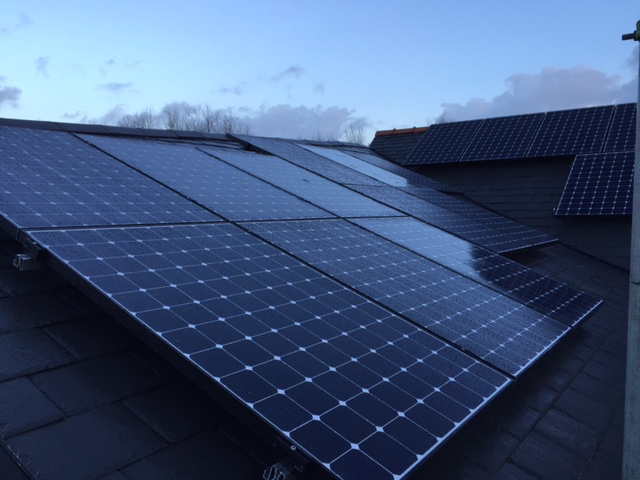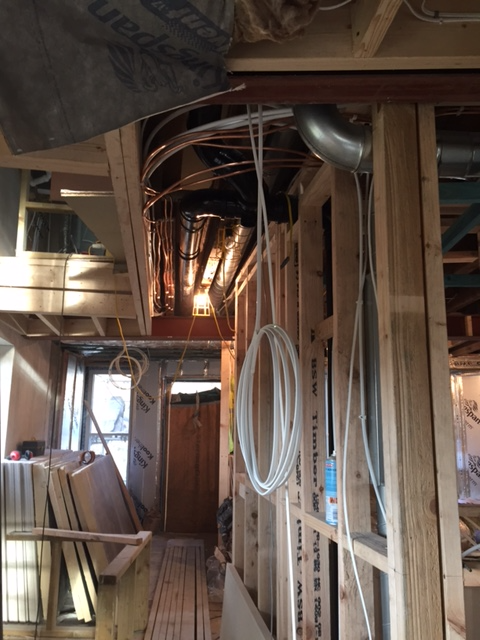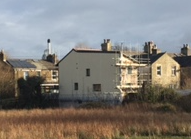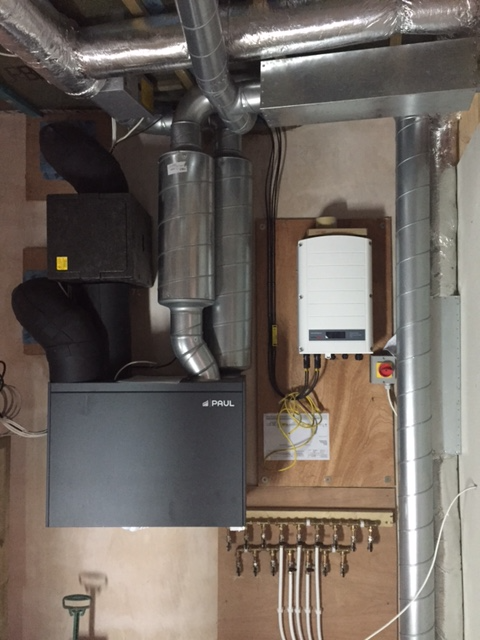December 2015
Solar PV Panels installed
13/12/15 15:45
The PV Panels were finally fitted during a 'quiet' period in the wind on Monday. But Sundog were the only team at work with Henry and Gideon forced to stay at home because of the flood damage to the rail network. Normal service resuming on the Tuesday. 16 of the 17 327 watt panels are shown below. The PV inverter still awaits final commissioning.

By Wednesday the site was in full flow with plumber and electricians joining the main team. Arranging all the pipes and cables requires thought and the main 'highway' on the ground floor is starting to look a little crowded.


By Wednesday the site was in full flow with plumber and electricians joining the main team. Arranging all the pipes and cables requires thought and the main 'highway' on the ground floor is starting to look a little crowded.

Progress despite the weather
05/12/15 17:41
The scaffolding on the Gable wall was removed last Thursday and the render revealed - but it is still not complete. The shape of the wall meant that the lower part of the gable can only be completed now the scaffolding has gone.

The scaffolding at the rear is scheduled to be adjusted for the external insulation/render after Sundog finally manage to fit the PV panels. The poor weather - mainly high wind speeds and persistent rain have caused delays.
Progress Inside has been very good. Robert and Matt have completed the first fix electrics apart from the Kitchen and 'Plant Room' whilst George, the Plumber, has started fixing the 10mm and 15mm pipes. Both the electricians and the plumber were slowed by the presence of the two Daves from Llangollen who fixed the MVHR system to a very high standard.

There appears to be plenty of space for the two Sunamp PV units below the MVHR unit.

The scaffolding at the rear is scheduled to be adjusted for the external insulation/render after Sundog finally manage to fit the PV panels. The poor weather - mainly high wind speeds and persistent rain have caused delays.
Progress Inside has been very good. Robert and Matt have completed the first fix electrics apart from the Kitchen and 'Plant Room' whilst George, the Plumber, has started fixing the 10mm and 15mm pipes. Both the electricians and the plumber were slowed by the presence of the two Daves from Llangollen who fixed the MVHR system to a very high standard.

There appears to be plenty of space for the two Sunamp PV units below the MVHR unit.
Storms cause problems
01/12/15 18:19
An unexpected problem emerged from the very high wind speeds last weekend. We paid a visit to the site on Sunday and noticed two large piles of polystyrene beads that had been used to top-up the old cavity wall insulation. (the smaller pile in the photo below)

We eventually managed to trace where the beads were escaping - from a small gap in the temporary tape seal around the MVHR Intake Duct. This was small enough for the very light beads to be moved by the pressure difference in the loft space into the main house. Over the course of two windy days the result was a depleted filled cavity though we were partially reassured that this was a small proportion of those added.
This posed a big problem because the beads were added to ensure the cavity was filled to at least the height of the Warmcell that had been blown in the now sealed loft the previous week. Without this cavity fill a potentially very nasty Thermal Bridge had been created at first floor ceiling level - the external air was potentially only around 100mm of brick away from the internal envelope!
So how do you get the beads back. Liam was clear that opening up the loft access and wading through the Warmcell would create many potential problems so he proposed sending the beads back into the cavity the way they escaped. After several frustrating attempts at finding a method that worked Liam thought of using the air leakage testing fan to increase the internal pressure in the house and thereby create a differential pressure between this and the attic space. It worked brilliantly - a tube placed above the container of beads worked like a vacuum and the beads were very rapidly send back to where they belonged.

We eventually managed to trace where the beads were escaping - from a small gap in the temporary tape seal around the MVHR Intake Duct. This was small enough for the very light beads to be moved by the pressure difference in the loft space into the main house. Over the course of two windy days the result was a depleted filled cavity though we were partially reassured that this was a small proportion of those added.
This posed a big problem because the beads were added to ensure the cavity was filled to at least the height of the Warmcell that had been blown in the now sealed loft the previous week. Without this cavity fill a potentially very nasty Thermal Bridge had been created at first floor ceiling level - the external air was potentially only around 100mm of brick away from the internal envelope!
So how do you get the beads back. Liam was clear that opening up the loft access and wading through the Warmcell would create many potential problems so he proposed sending the beads back into the cavity the way they escaped. After several frustrating attempts at finding a method that worked Liam thought of using the air leakage testing fan to increase the internal pressure in the house and thereby create a differential pressure between this and the attic space. It worked brilliantly - a tube placed above the container of beads worked like a vacuum and the beads were very rapidly send back to where they belonged.